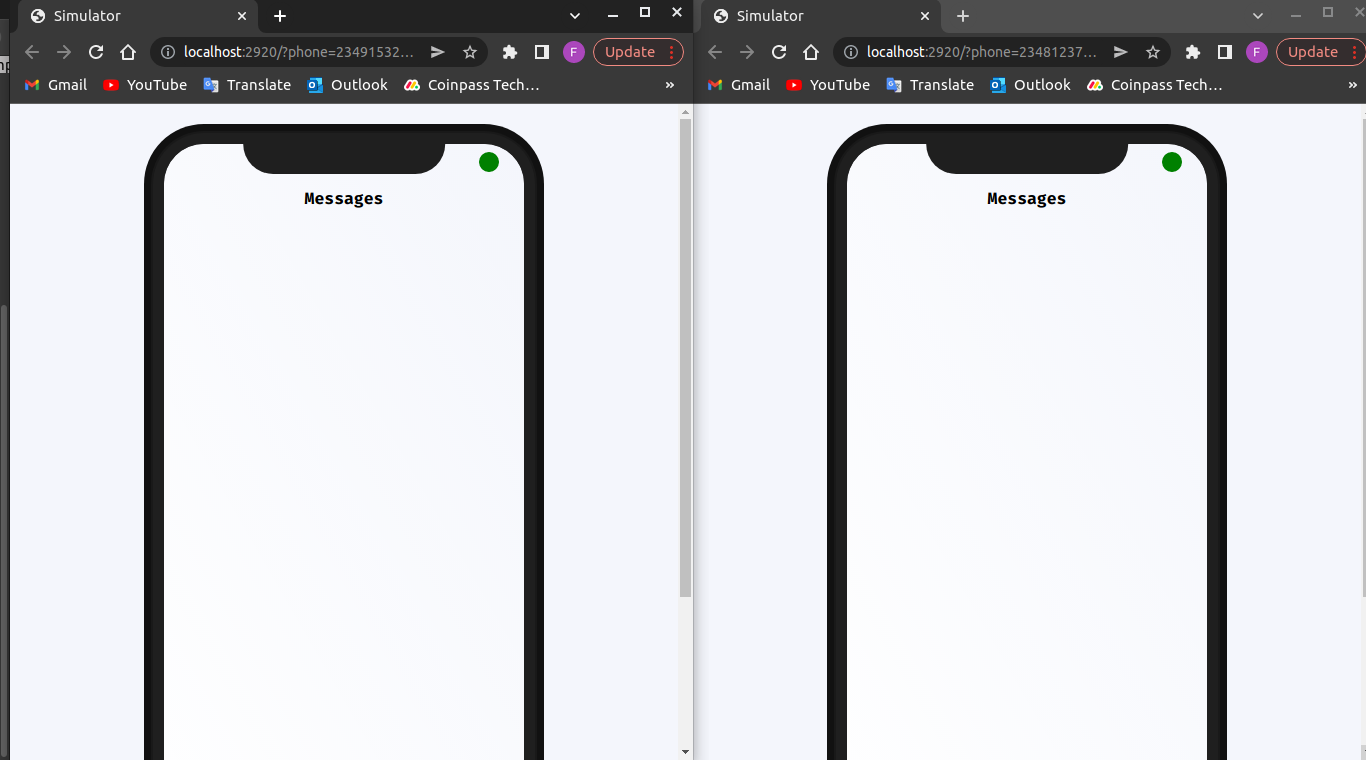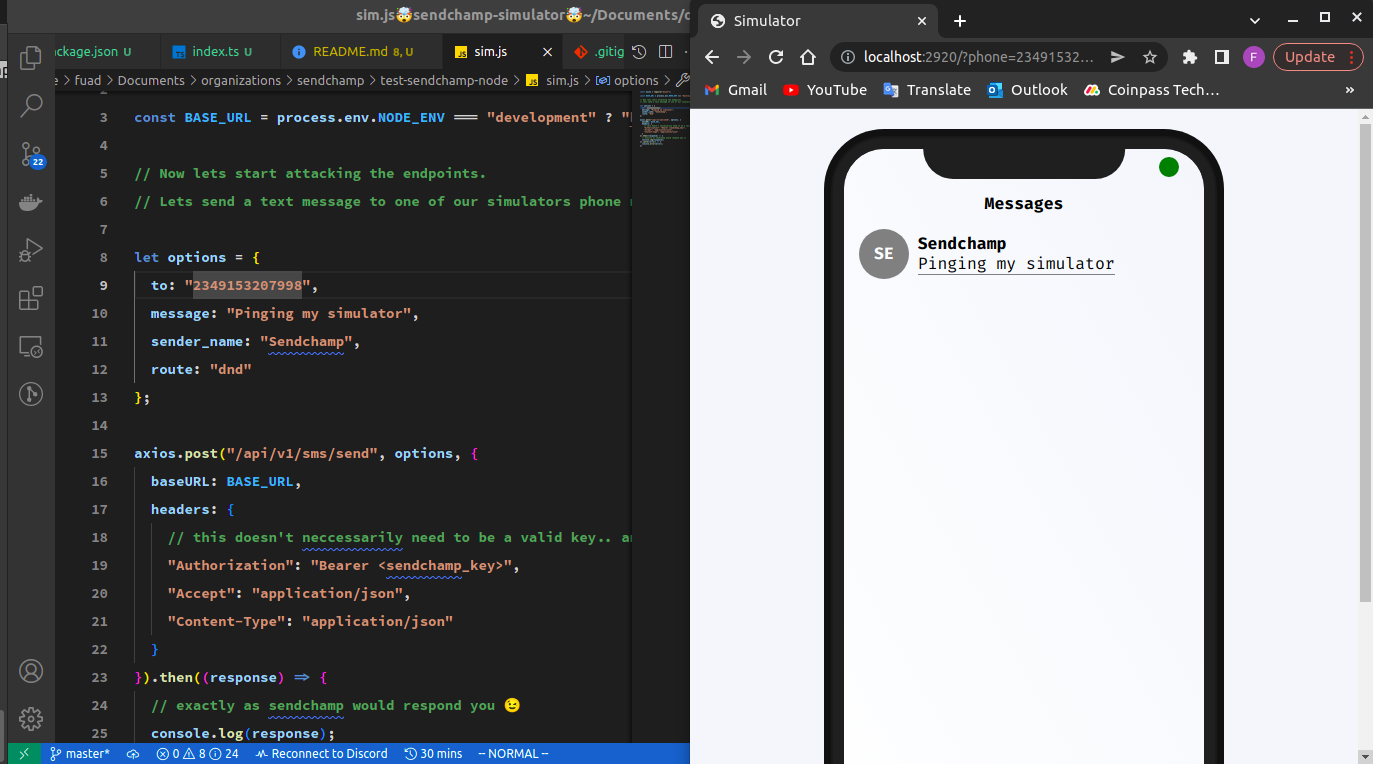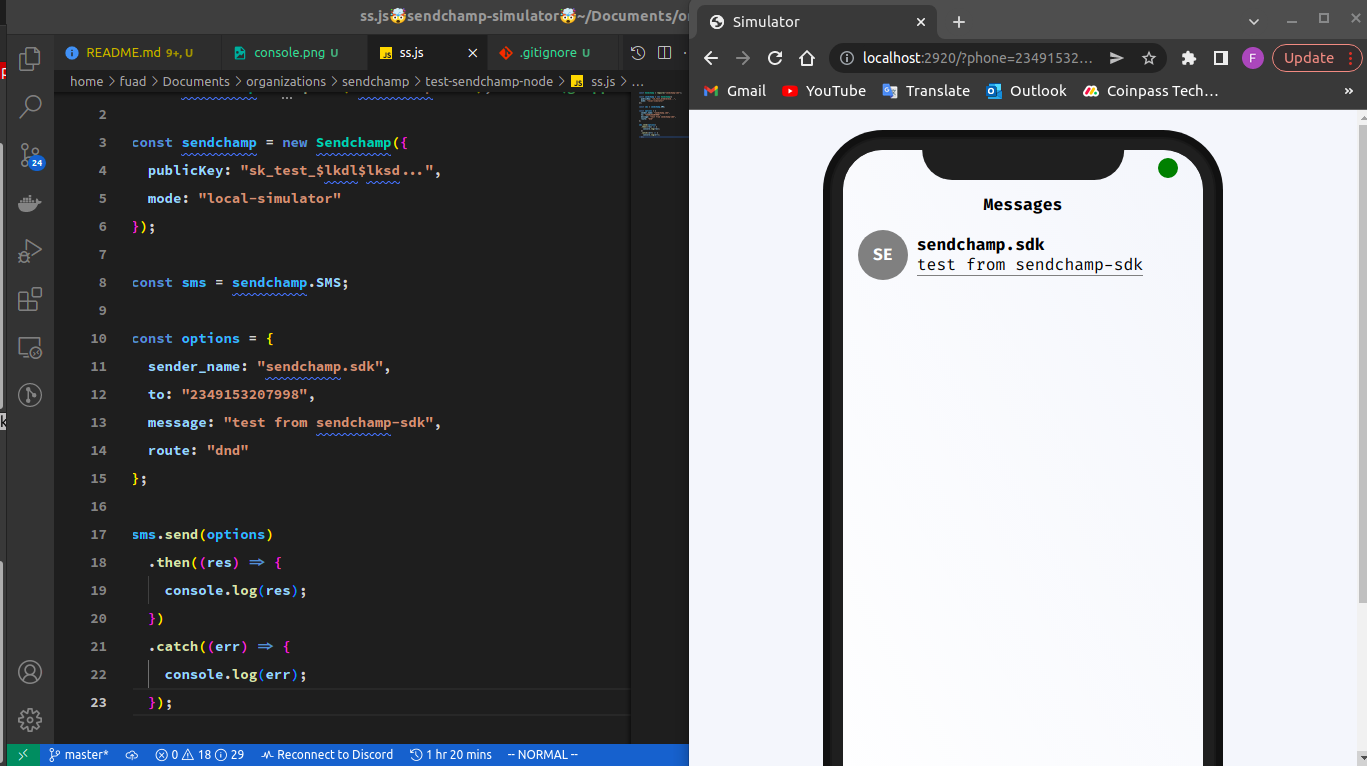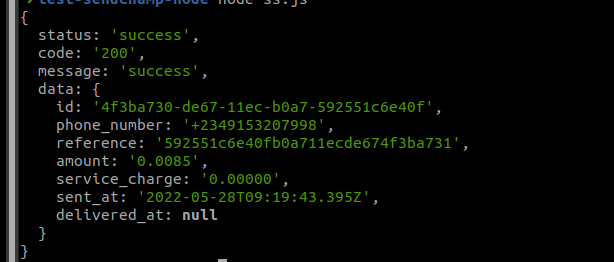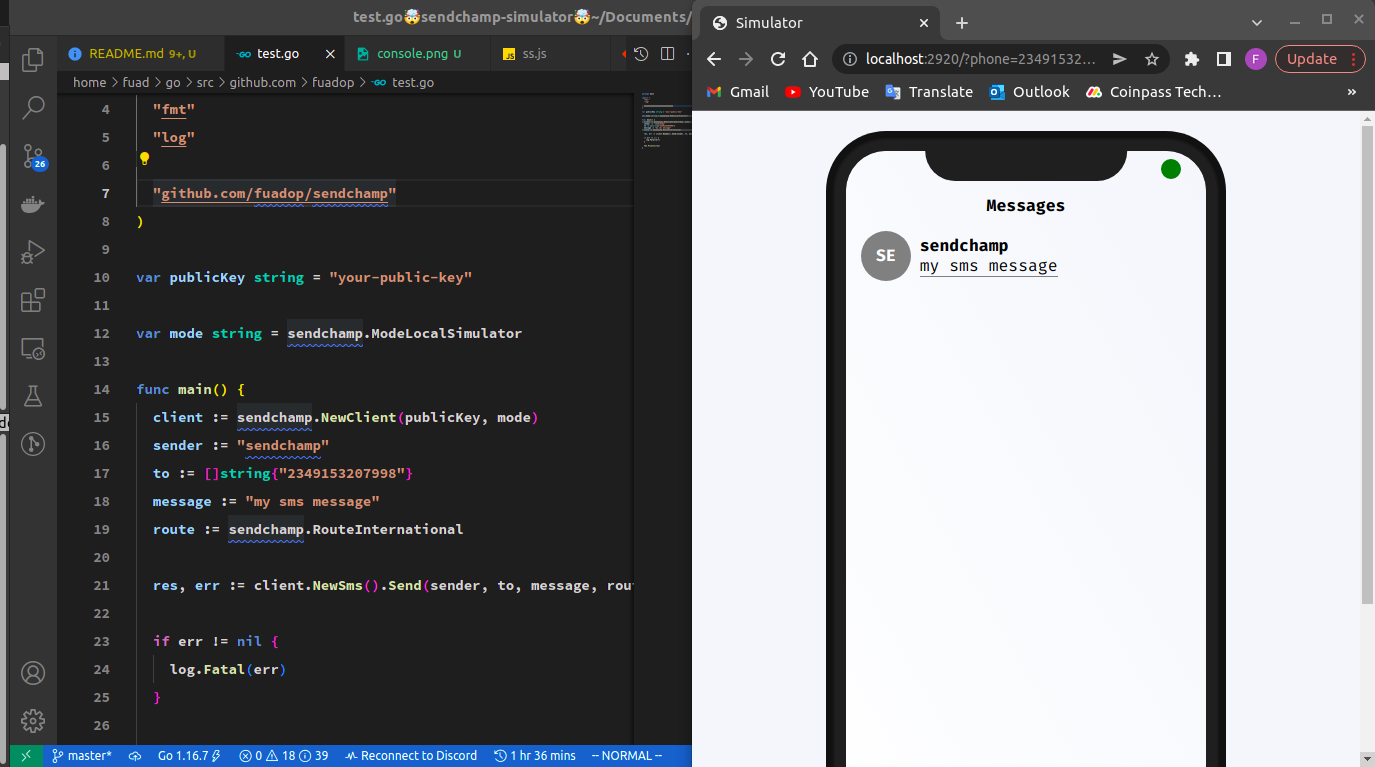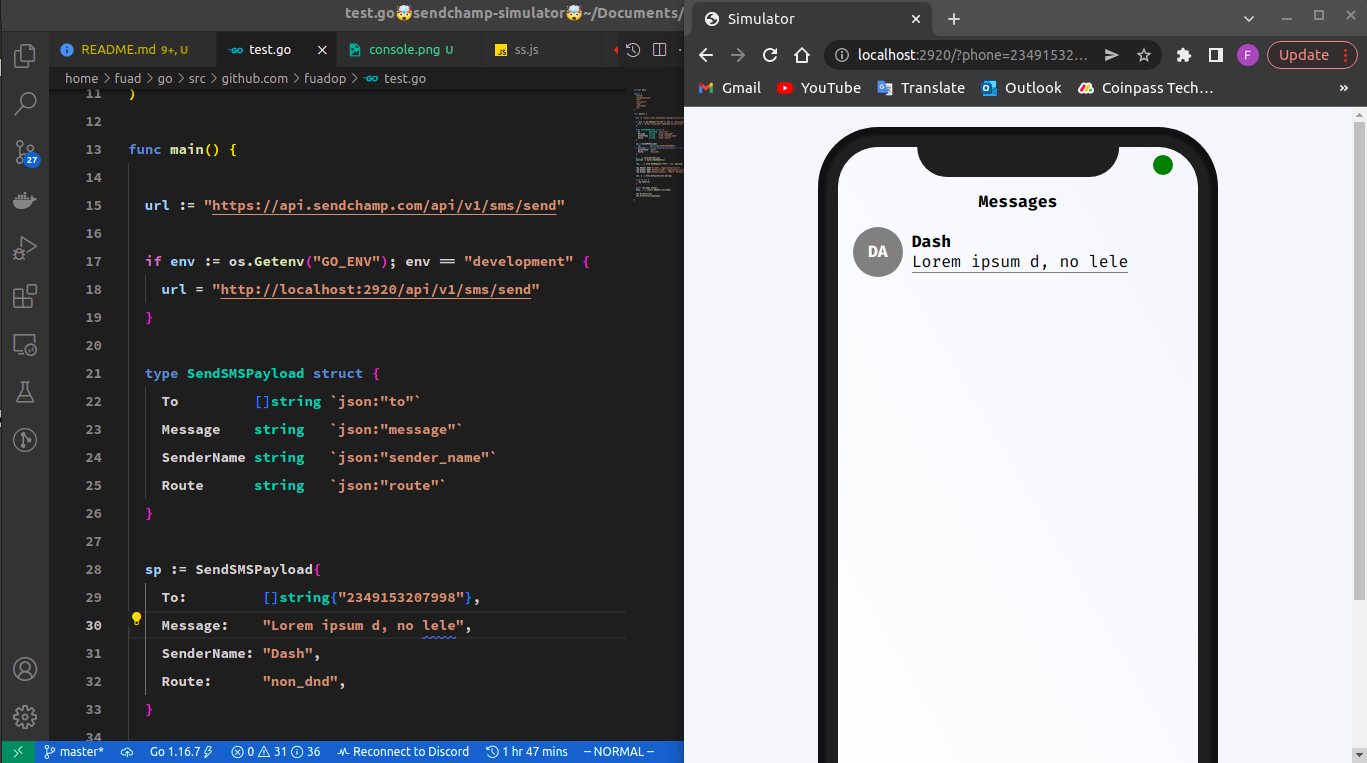Sendchamp Local simulator
Run a sendchamp simulator locally, to test your apps using sendchamp API without having to spend a dime, you can also write your unit tests with this tool.
Table of contents
Quick start
Setup
CLI Tool
Make sure you already have NodeJS + NPM installed. To run sendchamp-simulator, it's as simple as doing an npx which means running the latest version available on npmjs.com.
npx sendchamp-simulator --phone=2349153207998As seen in the above command, you need to specify a number for the simulator to receive text messages on. That doesn't mean you cannot run multiple simulators with different numbers. Of course you can !
[5/27/2022, 11:59:40 PM] Simulator started on http://localhost:2920/?phone=2349153207998So you have another number right ? Create a new browser tab copy and paste this url there, and you get a simulator for this number. Create a new tab again
For example: You want to run a simulator for both numbers 2348123775374 and 2349153207998. After starting the simulator: Go to your browser and open two tabs with the urls:
You see that green dot at the top right edge of the simulator ? If it's not green means your simulator isn't connected. Either you need to reload the page or restart your simulator ! Please don't use old browsers like Internet Explorer for this simulator or I would come for you
Lets gooo
Now that we have the simulator setup, It's time for us to start developing our app using the sendchamp api. I said sendchamp api right
Ideally you would have a constant holding the sendchamp api base url before making api calls in your app. So you can dynamically change this url based on your app environment. Let's see what I am talking about below.
Examples
Pardon me
Nodejs with axios
// use simulator url if in dev mode and live url in production
const axios = require("axios");
const BASE_URL =
process.env.NODE_ENV === "development"
? "http://localhost:2920"
: "https://api.sendchamp.com";
// Now lets start attacking the endpoints.
// Lets send a text message to one of our simulators phone number.
let options = {
to: "2349153207998",
message: "Pinging my simulator",
sender_name: "Sendchamp",
route: "dnd",
};
axios
.post("/api/v1/sms/send", options, {
baseURL: BASE_URL,
headers: {
// this doesn't neccessarily need to be a valid key.. anything works 😜. but if you want to use other endpoints like /wallet/wallet_balance you need to put a valid sendchamp public key, since those endpoints aren't intercepted and they go directly to api.sendchamp.com.
Authorization: "Bearer <sendchamp_key>",
Accept: "application/json",
"Content-Type": "application/json",
},
})
.then((response) => {
// exactly as sendchamp would respond you 😉
console.log(response);
})
.catch((error) => {
console.error(error);
});Now, let's check the simulator !.
And also in the console, we get the regular sendchamp response.
Nodejs with sendchamp-sdk
const Sendchamp = require("sendchamp-sdk");
const sendchamp = new Sendchamp({
publicKey: "sk_test_$lkdl$lksd...",
mode: "local-simulator",
});
const sms = sendchamp.SMS;
const options = {
sender_name: "sendchamp.sdk",
to: "2349153207998",
message: "test from sendchamp-sdk",
route: "dnd",
};
sms
.send(options)
.then((res) => {
console.log(res);
})
.catch((err) => {
console.log(err);
});Golang with sendchamp go sdk
package main
import (
"fmt"
"log"
"github.com/fuadop/sendchamp"
)
var publicKey string = "your-public-key"
var mode string = sendchamp.ModeLocalSimulator
func main() {
client := sendchamp.NewClient(publicKey, mode)
sender := "sendchamp"
to := []string{"2349153207998"}
message := "my sms message"
route := sendchamp.RouteInternational
res, err := client.NewSms().Send(sender, to, message, route)
if err != nil {
log.Fatal(err)
}
fmt.Println(res)
}Golang with net/http
package main
import (
"bytes"
"encoding/json"
"fmt"
"io/ioutil"
"log"
"net/http"
"os"
)
func main() {
url := "https://api.sendchamp.com/api/v1/sms/send"
if env := os.Getenv("GO_ENV"); env == "development" {
url = "http://localhost:2920/api/v1/sms/send"
}
type SendSMSPayload struct {
To []string `json:"to"`
Message string `json:"message"`
SenderName string `json:"sender_name"`
Route string `json:"route"`
}
sp := SendSMSPayload{
To: []string{"2349153207998"},
Message: "Lorem ipsum d, no lele",
SenderName: "Dash",
Route: "non_dnd",
}
j, _ := json.Marshal(sp)
payload := bytes.NewReader(j)
req, _ := http.NewRequest("POST", url, payload)
req.Header.Add("Accept", "application/json")
req.Header.Add("Content-Type", "application/json")
req.Header.Add("Authorization", "Bearer ACCESS_KEY")
res, e := http.DefaultClient.Do(req)
if e != nil {
log.Fatal(e)
}
defer res.Body.Close()
body, _ := ioutil.ReadAll(res.Body)
fmt.Println(res)
fmt.Println(string(body))
}Notes
The following endpoints communicate with the simulator:
- "/api/v1/sms/send"
- "/api/v1/verification/create"
Yes, sms OTPs would get received by the emulator and you can use the "/api/v1/verification/confirm" endpoint to verify it. If the channel set in the "/api/v1/verification/create" body is not "sms" the request is processed by "api.sendchamp.com".
All other endpoints not listed above are all processed by "api.sendchamp.com". Your local simulator is a proxy
Timeline
Currently the simulator works for all sms based requests. I am looking into also intercept the voice based requests to the simulator, if that would be necessary.
If you find any bugs or have a feature request, please file an issue on the issue tracker, I'll be happy to help!.
Contributing
PRs are greatly appreciated, help us build this hugely needed tool so anyone else can easily test their apps using sendchamp.
- Create a fork
- Create your feature branch:
git checkout -b my-feature - Commit your changes:
git commit -am 'Add some feature' - Push to the branch:
git push origin my-new-feature - Submit a pull request
🚀

